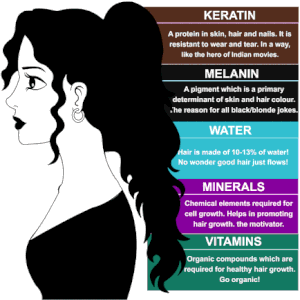I am Hairini, yeah the name is a product of numerology but being a hair care expert, perhaps the spelling was just a destiny. Of late, I have been seeing a large number of people losing sleep over losing hair. Day by day, there is an increase in the volume of hair in their comb to that on the scalp. With palms on their forehead and their eyes cursing the mirror, they try every possible solution ranging from highly expensive choices like ‘TV advertised’ hair oils to the cheaper choices like changing their comb (!). But the good thing here is most of them have started caring about their hair. For those who don’t, ‘today’ is always an auspicious day to start caring and ‘now’ is the best time to.
As a hair expert, I always believe that caring for hair starts with a good understanding of it. Hence this blog is to make those caring individuals understand their hair first and make the bonding between their hair and scalp tight.
THE HAIR MACHINERY
Just like our Indian cricket team that is made up of batsmen, bowlers, all-rounders and Sir Ravindra Jadeja, our hair is made up of a number of elements that are vital to its existence. The picture below will guide you through a hair’s manufacturing unit where a number of small machines work together to form your beautiful hair.
The order should be Hair Follicle, Dermal Papilla and then Sebaceous Gland.
Hair Follicle:A pouch shaped structure within which the entire hair machinery functions. If hair is a gift, the follicle is the gift wrap.
Sebaceous gland:The lustrous shine on your hair is because of the oil secreted by this gland to avoid friction. No use in praising your shampoos alone!
Dermal papilla:This is the gateway for blood vessels and in flows the essential nutrients such as amino acids, vitamins, minerals etc. No entry fees.
THE HAIR INGREDIENTS
THE HAIR PACKAGING:
The portion of hair that we see outside from the scalp is called SHAFT. So when Rajnikanth stylishly caresses his hair, what we actually see is a cluster of hair shafts. This Shaft, in turn, can be divided into three layers inside, as depicted in the following image.
THE HAIR GROWTH PHASE:
We live in a world where nothing, ranging from Prime Minister to pencil box, is permanent. How can growth alone be permanent? The growth of hair follows a definite cycle, as in the image below.
Anagen, the growth phase:
- Occurs for 3 to 7 years
- 90% of hairs are in this phase at any given time.
Catagen, the transition phase:
- Occurs for 1 to 3 weeks
- Hair follicle shrinks to about 1/6th of the normal length
Telogen, the shedding phase:
- Occurs for 1 to 3 months
- 10 -15% of hairs are in this phase at any given time
THE COMMON HAIR PROBLEMS:
A Hair without problems is water without wetness … a nation without politician … a country without taxes. They are inevitable, like politician or taxes. Since hair is essential to our identities, we would love to hold on to them as much as we can in the scalp. But holding them in our comb? Well, that’s fearsome. One way to drive away the fears is to understand the normal hair problems better. To remove unnecessary fears, there has to be a sound knowledge of hair issues. Of the problems I see, the following four are the most common problems associated with the hair.
DANDRUFF
Dandruff is the skin cells that grow and die off too fast. The shedding of these cells from the scalp is what you see as white powder on your shoulders. The microbial origin of dandruff is yeasts (fungi) of the genus Malassezia.
HEAD LOUSE
This pestering parasite that thrives on your scalp is a common problem in the lives of many. The main way to avoid a lice attack is to maintain proper scalp hygiene and regular hair cleansing.
TREATED HAIR
It’s common to use chemical treatments to make your hair straighter, curlier or more colourful. But the process of making extreme changes can cause lots of damage to your hair. Even hot blow drying and ironing your hair break the natural chemical bonds in your hair and force them into a new shape.
THINNING OF HAIR
When your hair’s natural growth cycle slows down, thinning or loss of hair occurs. This is mainly due to hormone imbalance, genetics or due to some physical trauma.
I hope you are a bit more informed and relaxed at the moment after reading the contents of the post. Keep looking at the mirror admiring your hairstyle and stop cursing your comb for acting as hair magnets. I will be back with more information in the next post. Until then, this is Hairini, the hair care expert, signing off.


Comments